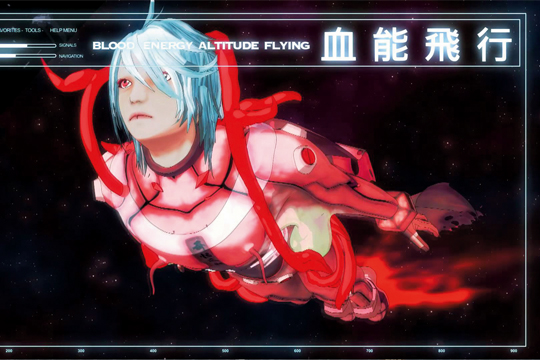LU YANG: UTERUSMAN
| January 15, 2014 | Post In LEAP 24

Lu Yang’s “Uterusman,” a semi-open-source work featuring the eponymous genderless superhero warrior, takes the inspiration for its protagonist’s physique from the shape of a female uterus, itself resembling the outline of a person standing with feet planted and arms outstretched upwards. A 3D animation introduces us to the armor-clad hero’s impressive range of genetic and biological “superpowers,” including, most notably, the ability to alter genes and other hereditary functions. The OP trailer for the animation made an appearance last year at UCCA’s “ON | OFF,” and the current Shanghai exhibition marks the premier of the full-length animated portion of the work (animation, color, sound, 10 min. 15 sec., music by Squareloud), as well as a comprehensive display of Uterusman “art market” paraphernalia. The focal point of the exhibition layout is the animation projection zone, with four walls extending outwards to showcase a variety of other forms: a limited edition t-shirt—and product of a brand collaboration—a sculpture of the “Pelvis Chariot” ridden by the Uterine warrior, the official character book, and all manner of other digital inkjet curios. The collection shown here is just the tip of the iceberg Lu Yang has output over the course of a year’s worth of preparation.
The organisms, the warriors, the coordinated color schemes, and the overall aesthetic presented here make it clear that the artist has absorbed and identifies with Japanese anime culture. This is apparent not only in her character designs, key images, derivative products, and cosplay work, but also in the process by which these modern cultural medial forms have undergone their transmission. The work has been celebrated by many, commented on by even more. This outcome is precisely what the artist had been hoping for, and why she chose the semi-open-source format: so that the work itself could be an ongoing, shared project, possessing the vitality of a piece always in development.
“Uterusman,” in addition to its exaggerated, surrealist animated aesthetic, exhibits a clear stance with regard to a wealth of socio-psychological issues. Uterusman’s “superpowers”—among them “DNA Gene Attack” and “Chromosome Attack”— reference society’s collective anxiety over the deterioration of our natural environment and the onset of countless possible, mysterious, seemingly unstoppable diseases and genetic mutations in an age of ever-deepening advances in bioinformatics research. We also see the repulsive “Baby Weapon,” always on standby with an evil twinkle in its eye. The sight is a challenge to the majority’s morality and posits another possible dimension of reality, in which not all children are so cute. Almost everyone has been annoyed at some point by a kid who won’t seem to stop shouting and crying (in Chinese, we even a specific vocabulary for it: “bear cub children”).
To understand the intent behind “Uterusman,” we must see it in the context of the artist’s overall practice. Lu Yang is not playing the role of radical critic here; on the contrary, she has consistently cultivated a disposition geared towards simplicity and plainness. Her interest lies merely in explicating and further exploring a set of basic realities, and doing so from a biological perspective. These “basic realities” were explored earlier on, for example, in the frogs she controlled by electrical impulses (a work that suffered much vilification due to misunderstanding; the frogs were not alive, but carcasses, specimens already fated to destruction upon the completion of a medical experiment). Society often neglects or downplays our nature as biological beings: part of the chain reaction of the widening gap between academic frontiers and public awareness. Lu Yang’s exploration of these issues is intimately linked to her frequent participation in professional and academic seminars, which explains her familiarity with current trends in research and existing technologies in neuroscience, psychology, and other related fields. Her reserve of interdisciplinary knowledge is what allows her work to transcend simply probing “possibility” or proving “relevance,” and dig deeper into the real details.

